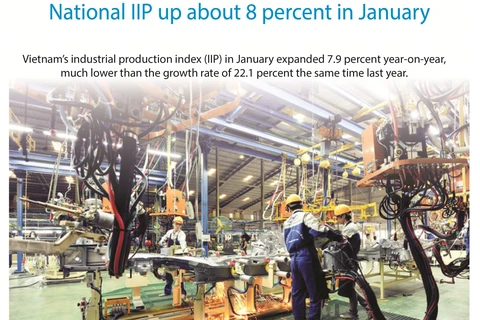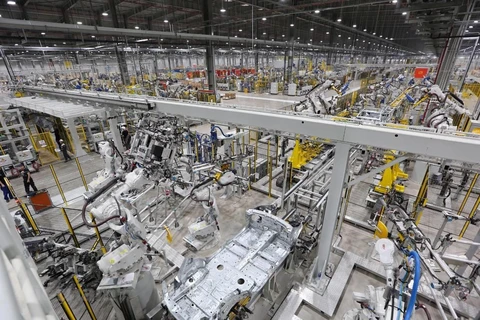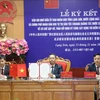Hanoi (VNA) – Vietnam’s index of industrial production index (IIP) in May expanded 4.6 percent against the previous month and 10 percent year-on-year, the General Statistics Office said on May 29.
In the first five months of this year, the index rose 9.4 percent year-on-year, lower than the growth of 10.3 percent recorded in the same period last year but higher than 7.4 percent and 6.6 percent in the corresponding time of 2016 and 2017.
The processing and manufacturing sector, responsible for a large part of domestic industrial production, reported the IIP growth of 10.9 percent while the IIP growth of electricity production and distribution stood at 10.3 percent and that of water supply and waste-sewage treatment sector reached 7.9 percent.
Meanwhile, the mining sector’s IIP dropped 0.1 percent year-on-year, according to the GSO.
Some major industrial products achieved high production growth in the first five months, such as coke coal and refined mining products (84 percent), metal (40.5 percent), ore exploitation (14.9 percent), motor vehicles (14.7 percent) and rubber and plastic products (14.1 percent).
However, others experienced slight growth or even declines in the IIP, such as electronics, computers and optical devices (up 3.1 percent); tobacco (up 2.6 percent); medicines, pharmaceutical chemicals and pharmaceutical material production (up 1.4 percent); production of other vehicles (down 2.3 percent); services in support of the mining industry (down 3.5 percent); and exploitation of crude oil and natural fuels (down 4 percent).
The GSO said as of May 1, the number of labourers in industrial firms increased 1.4 percent month-on-month and 2.2 percent year-on-year. Employees in State-owned businesses contracted 0.9 percent while those in non-State and FDI enterprises rose 1.3 percent and 3.1 percent.
During January-May, the processing and manufacturing sector attracted the largest amount of FDI, with total capital in new projects exceeding 4.7 billion USD, 73.5 percent of accumulated investment in new projects overall.
Additional and new capital injected in the sector in the period was more than 7.01 billion USD, accounting for 77.2 percent of the total.
Experts said the country’s industrial growth was driven by increases in the number of enterprises, investment capital and labourers. Meanwhile, productivity remained low and gaps with other countries like China, Malaysia, Indonesia, the Philippines, India, Thailand, Japan and the Republic of Korea continued to widen.
Industrial growth, especially the processing and manufacturing sector, still relied on FDI firms.
Experts, therefore, suggested creating national branded and competitive products, integrating more deeply into global value chains and stepping up industrial structural reform.-VNA
VNA























